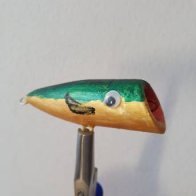I've got a bunch of lures turning right now, and I can see fish eyes developing. Just wanted to check whether my fixing idea is good enough.
Just to give some background, I've got an assortment of crankbaits and poppers on the rack, hand painted (don't have an airbrush) with acrylic paints. This first clear coat is with 24 hour epoxy, and I honestly didn't know that contaminants from my hands could cause divots to form in the epoxy. Live and learn, I guess.
What I'm thinking of doing tomorrow, once this lot's hardened, is sand them down a little, then give the lures a quick rub down with a bit of soapy water on some tissue paper (I'll be wearing gloves this time) to get rid of any contaminants. Then I'm going to wipe them down with a damp bit of tissue, then dry them off. Once all this is done, the second coat goes on.
Do you think this will work?




